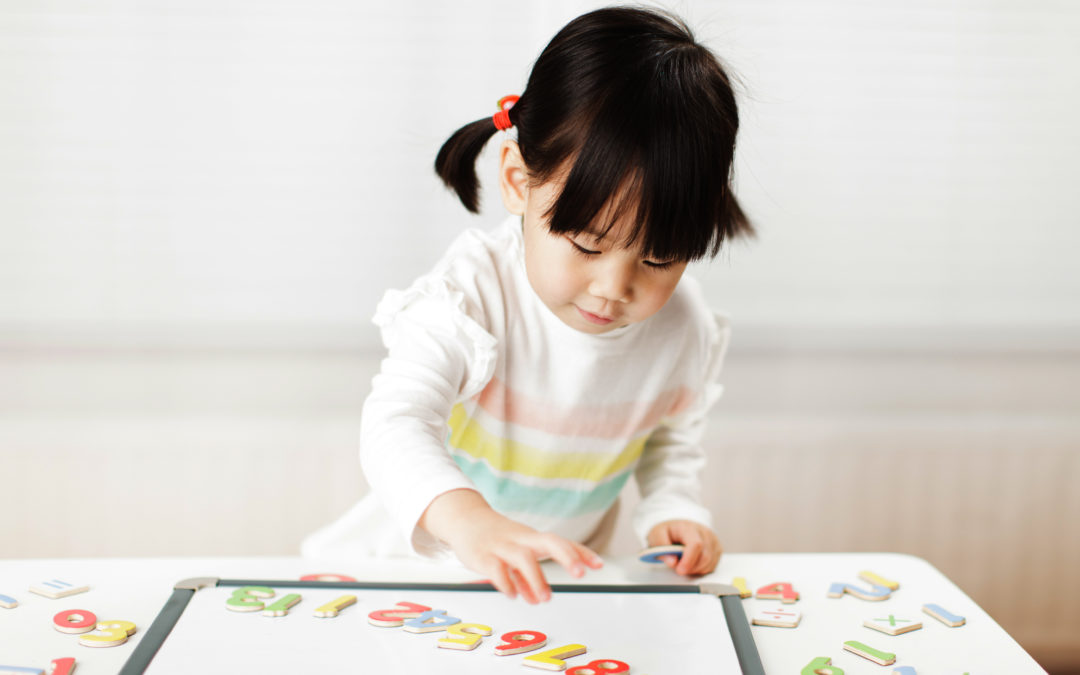Even before they can speak, children are able to comprehend the general relationship between numbers and objects. As their verbal capacity grows, they are primed to understand and articulate basic mathematical concepts. Children’s songs and nursery rhymes, sets of blocks and the tiny “O’s” of Cheerios provide the earliest examples of patterns and numbers, offering natural learning opportunities. Math is everywhere, and it can be introduced to your child as organically as language itself. A positive attitude toward math learning and learning in general can develop in early childhood and inform a child’s academic experiences for years to come.
Count together
Count with your child wherever and whenever you get a chance and make it a regular activity. Counting blueberries in a bowl, steps on a stairway, or buttons on a jacket, can be a fun way to help children become more comfortable with hearing numbers and understanding their meaning. Figuring out the relationship between an item and a number allocated to it is called one-on-one correspondence, and it is a precursor to almost all mathematical concepts. If a toddler’s one-to-one correspondence skills are well developed, it will put him or her an advantage in the academic setting, allowing better comprehension of basic math concepts.
Add and Subtract
Be it the naughty little monkeys jumping on the bed or the infamous speckled frogs sitting on a speckled log, there are plenty of representations of addition and subtraction in the early development vernacular. Sing and count with your child, and try to apply the same math principles (1+1+1+1+1=5 and 5-1-1-1-1-1=0, and the like) to the fingers on your hand, shoes on a shoe rack, birds on a tree branch, etc. We might take it for granted, but for a young child the concept of the same number being applicable to different objects is a novel one.
Sort Objects
A good way to help one-to-one correspondence is to group objects that go together. Spoons can be distinguished from forks, toy cars from toy airplanes. Using a group of similar objects is also a good way to demonstrate what “more” or “less” look like. Sorting toys or household objects by shape, color, or other characteristics could keep the two of you busy for a while and make space for learning new words and numbers. Sorting while doing chores around the house can be easy to arrange: you can guide your toddler in the fine art of sorting socks and grouping them in matching sets of two!
Introduce measurement
While specific units of measurement like ounces, pounds, inches, and feet can be introduced later in your child’s development, concepts of weight, height, and length can be explained and explored relatively early. One of the greatest and most natural way to teach children to measure, add, and estimate is letting them into the kitchen where they can help fill, stir, and pour.
Clocks and calendars are wonderful educational tools, as they utilize counting, sequences, and pattern to represent and measure time. A calendar can be used to help your child quantify time between dates and days of the week, different seasons and upcoming celebrations. Using an hourglass, stopwatch, or timer to time activities lasting 1-3 minutes can allow for a more immediate visual and sensory experience of time. For parents willing to brave the digital world, there is a cute visualization app called Mouse Timer that expresses the length of time with little mouse gnawing through apples.
Teach Patterns
Together with your child you can sing songs that rhyme, repeat, or have numbers in them. These songs, as well as nursery rhymes and a selection of popular children’s books are a great way to practice language and foster social skills. They are also a fine teaching tool for a mathematical skill of identifying patterns. Help your child develop greater focus and attention for detail by pointing out finer visual patterns, like architectural elements or textile designs on their clothing.
Name shapes
Make it a habit to point out and describe the different shapes you see during the day. Including other descriptive qualities, like color or quantity, help your child recognize and memorize the shapes and their names. Be it a triangle of a roof, or a circle of a plate – finding shapes can be a fun game at home, on a walk, or at a doctor’s office. Cutting up construction paper into shapes and combining them into simple collages can be a fun craft project, and a valuable visual aid. Make sure that your child’s toy selection includes simple wooden blocks, interlocking blocks, and shape sorters. You can also utilize cardboard boxes, kitchen containers, plastic cups, empty paper towel rolls and the like. By combining, stacking, and manipulating these objects kids can learn about shapes and the relationships between them (two squares can make a rectangle, two triangles can make a square, etc.)
Introduce spacial relationship
The ideas of shape, size, space, position, direction, and movement are best explored in comparison (which dog is bigger?), assessment (how many trees did we see?), recognition of similarities and differences (is this pumpkin smooth, or bumpy like the other one?) and categorization (let’s gather the yellow leaves). You can talk to your toddler about size (which tree is bigger?), estimate distance (is grandma’s house close or far?), and practice counting (let’s count how many steps are on our stairway?) A simple walk around the block can provide a selection of wonderful visual aids for every one of these concepts.
Help kids learn to tolerate frustration
A survey of high school students conducted in 2013 showed that having to tolerate the frustration associated with solving mathematical problems presents the greatest difficulty with successful learning. We can think of frustration is an emotional response that occurs when a project goes wrong or a hope or desire doesn’t come true. The experience is familiar to children and adults, alike. It’s important to remember that learning to tolerate and successfully manage feelings of frustration at an early age is key to effective emotional functioning down the line. Helping our little ones accept that life is made up of both failure and success is one of the hardest jobs of parenting. Patience and affection from their caretakes is what children need as they learn about the world through words or numbers.
If you need guidance in helping a toddler increase tolerance for frustration, we at ECDA can offer a number of techniques and strategies that could be key to your child’s (and yours) emotional wellbeing. Teaching our littlest clients sophisticated mathematical and linguistic concepts through imaginative play is another important part of what we do. Please call us at (323) 655-5580 for a consultation, our parenting classes, or our therapeutic services.
Your Title Goes Here
Your content goes here. Edit or remove this text inline or in the module Content settings. You can also style every aspect of this content in the module Design settings and even apply custom CSS to this text in the module Advanced settings.


Recent Comments